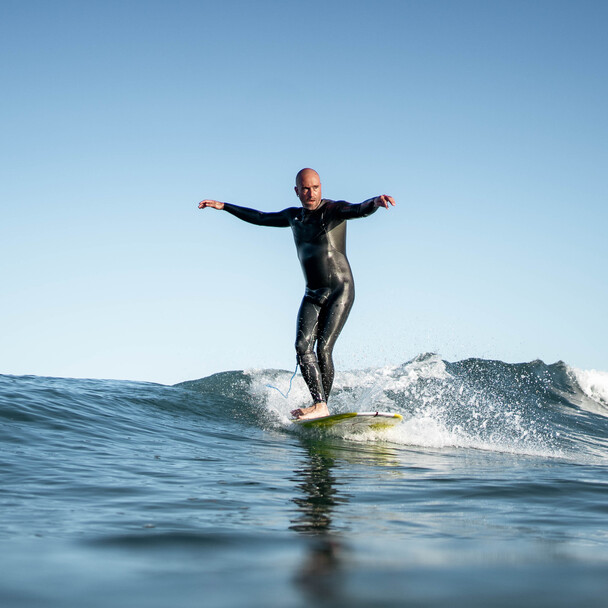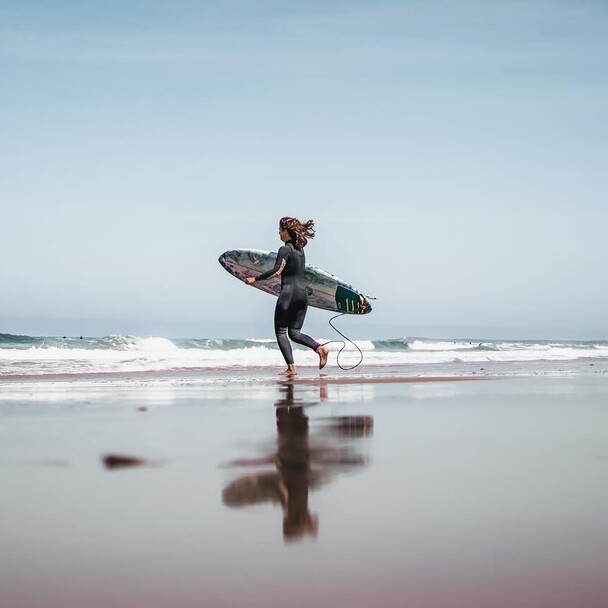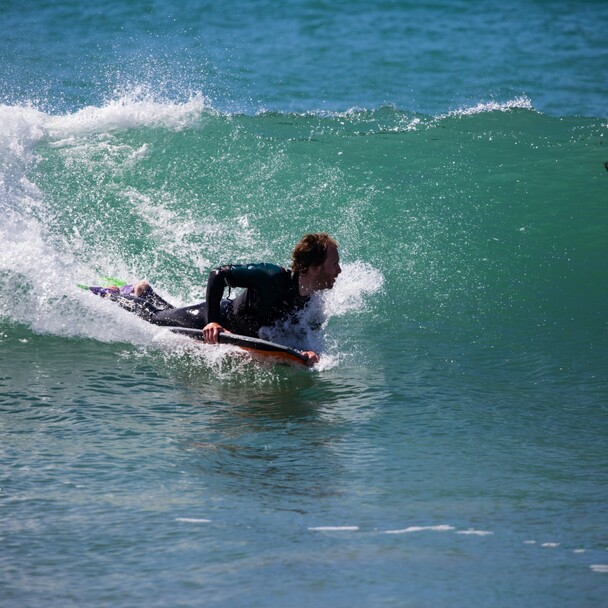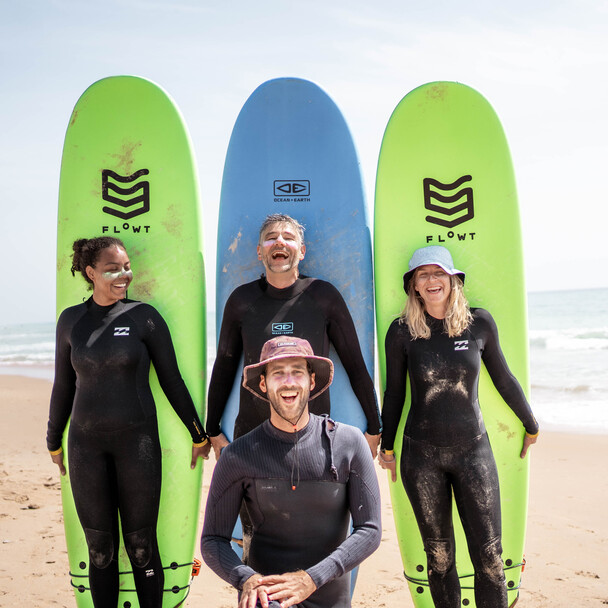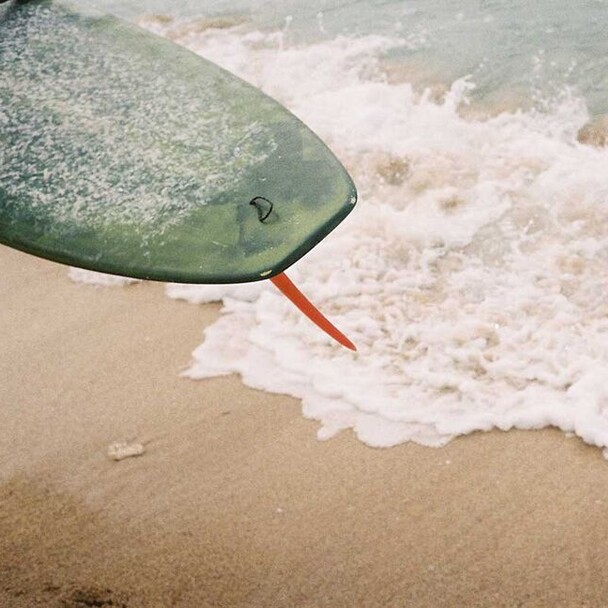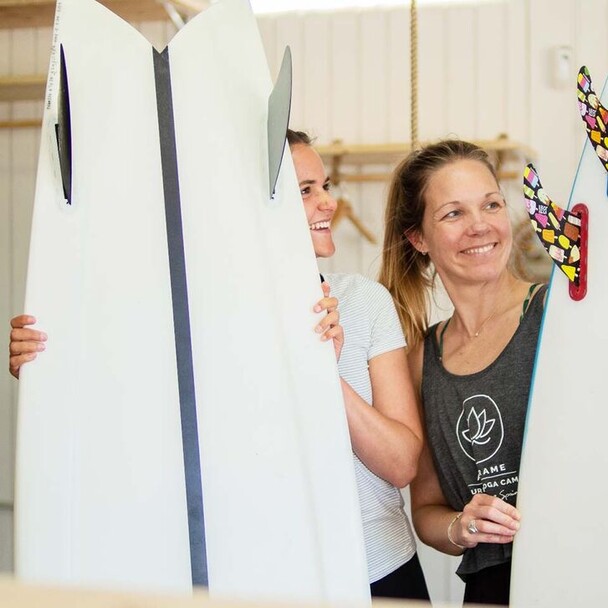The Surfboard - The ultimate guide including types, materials, care and more
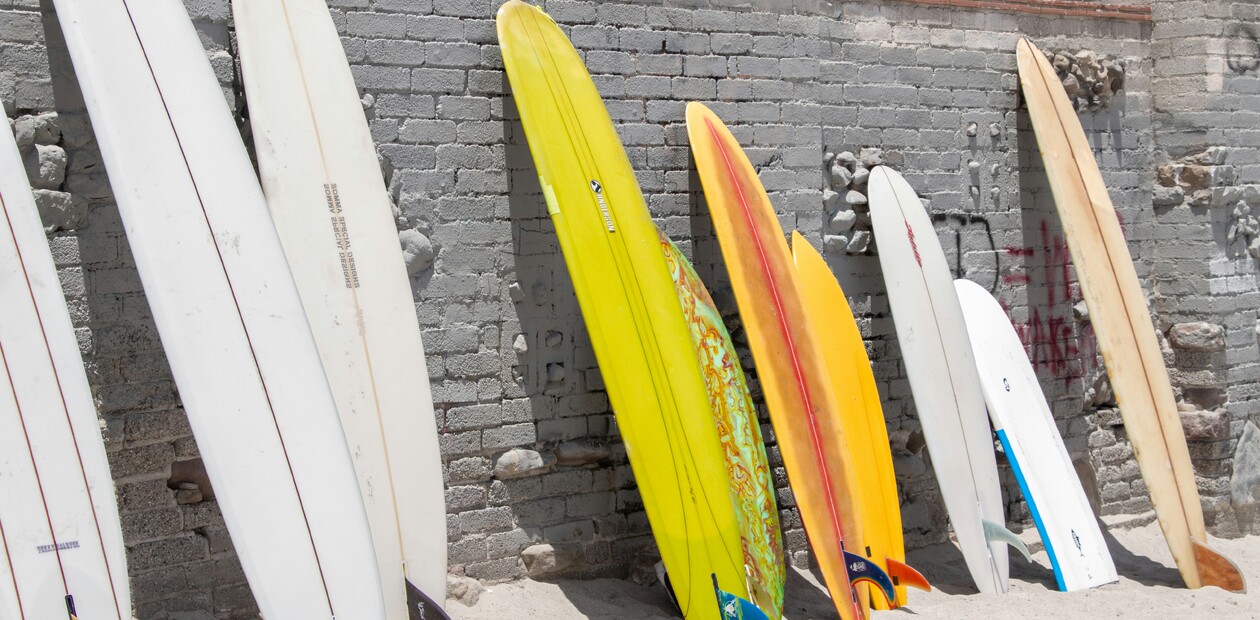
- Importance of a suitable surfboard for beginners and advanced surfers
- History of surfing and the surfboard
- Origin of surfing (Hawaii and Polynesian culture)
- Development of the surfboard in the 20th century
- Spread of surfing worldwide and in Germany
- Types of surfboards
- Longboards
- Shortboards
- Funboards
- Gun Boards
- Bodyboards
- Mid Length
- Single Fin
- Egg
- Hybrid
- Step Up
- Summer Shortboard
- Fish
- Softboards
- Tow-In Boards
- Conclusion Types of surfboards
- Which Surfboard Should You Buy & Use? Video
- Fancy surfing? Book your surfing vacation now.
- Surfboard dimensions
- Important key figures of a surfboard
- Finding the perfect surfboard is a compromise
- Volume from the surfboard
- Explanation volume surfboard
- Video Fat Surfer
- Why is the volume of a surfboard important?
- Calculate surfboard volume
- Typical mistake: The smaller the better?
- Bought a new surfboard? Book your surfing vacation now.
- Materials and construction of surfboards
- Core materials
- Coatings
- Differences in performance and durability
- Shape - nose, tail and rails of surfboards
- Surfboard Nose
- Surfboard Tail
- Surfboard rails
- Concave vs. convex
- Bottom condition of a surfboard
- Surfboard fins
- Single Fin
- Twin Fin
- Quad fins
- Thruster fins
- Care and maintenance of surfboards
- Correct storage
- Repair of dents and scratches
- Cleaning and care of the fins
- Additional equipment for surfing
- Leash (safety line)
- Wax for the surfboard
- Wetsuit and other protective equipment
- Tips for buying a surfboard
- New vs. used surfboard
- What to look out for when buying a surfboard
- Manufacture and sale of surfboards
- Production volume and sales
- Production sites
- Difference between a shaper and industrial production
- Video of the surfboard shaper
- Conclusion surfboard
- Summary of the most important points

Arne has been surfing since 1996 and runs the camp with extensive knowledge from surf trips around the world. He is a qualified and licensed surf instructor from the British Surfing Association (BSA) and the International Surfing Association (ISA) as well as a qualified sports scientist and personal and fitness trainer. With his ISA Level 2 Surf Coach Diploma and many years of experience, he offers professional and holistic coaching.
Importance of a suitable surfboard for beginners and advanced surfers
Surfing is more than just a sport - it's a way of life. Whether you're getting on a board for the first time or have been chasing waves for years, the right surfboard is crucial to your experience on the water. It's your faithful companion to help you catch the perfect wave, maintain your balance and improve your skills.
For beginners, choosing the right surfboard can make the difference between frustration and joy. A well-chosen board offers stability, makes paddling easier and makes it easier to get up on the first waves. Longboards and funboards are often the best choice here, as they have a wider and longer design that offers more buoyancy and balance.
Advanced surfers, on the other hand, need a board that supports their specific needs and individual style. This is where different types such as shortboards, fishboards and guns come into play. These boards are more agile, more responsive and allow for more complex maneuvers on bigger and faster waves. Choosing the right board can significantly improve your performance and help you master new tricks and techniques.
No matter what level you surf at, your surfboard is the heart of your surfing adventure. It's worth investing time and thought into your choice to get the best out of every session.
Tip: At our A-Frame Surfcamp you can test different surfboards.
History of surfing and the surfboard
Origin of surfing (Hawaii and Polynesian culture)
Surfing has its origins in Polynesian culture and is deeply rooted in the history and tradition of the Hawaiian Islands. The first records of surfing date back to Captain James Cook, who observed Hawaiians riding the waves in 1778. For the Hawaiians, surfing was more than just a sport - it was a spiritual and cultural practice closely linked to their religion and daily life. The chiefs and kings used special surfboards known as "Olo", while the common people surfed on "Alaia" boards.
Development of the surfboard in the 20th century
In the 20th century, surfing and the development of the surfboard made significant progress. In the early 1900s, Hawaiian surfer Duke Kahanamoku brought surfing to California and Australia, where it quickly gained popularity. The first modern surfboards were made from solid wooden planks, but were very heavy and unwieldy.
Over time, new materials and technologies led to lighter and more maneuverable boards. In the 1950s and 60s, the introduction of polyurethane foam cores and fiberglass coatings revolutionized the design of surfboards. These materials made boards lighter, stronger and more versatile, making surfing accessible to a wider public.
Spread of surfing worldwide and in Germany
Surfing spread worldwide over the course of the 20th century. In the 1960s, it became a mass phenomenon in the USA and Australia, supported by films such as "The Endless Summer", which popularized surfing as a lifestyle.
In Germany, surfing began in the mid-1950s. Sylt lifeguards started their first attempts on lifeboards, which were not suitable for surfing. The German surfing scene developed slowly but steadily. In 1966, the "Surfing Club Sylt" founded the first official surf club in Germany. The founding of the German Surfing Association (DWV) in 1991 marked another milestone. Today, surfing is firmly established in Germany, with a lively scene and well-known surf spots such as the Eisbach in Munich.
Surfing is now a global phenomenon and an Olympic discipline that inspires and excites millions of people around the world. The continuous development of technology and the passion of surfers have made surfing what it is today - an exciting mix of sport, culture and lifestyle.
Types of surfboards
The world of surfboards is as diverse as the waves they ride. Each board is designed for different conditions and surfing styles, so there is the perfect model for every surfer. From stable longboards for beginners to maneuverable shortboards for pros - the choice is huge. Here you can find out all about the different types of surfboards and their specific areas of use so that you can find exactly the right board for your needs.
Longboards
Explanation: A longboard is a large surfboard, typically over 9 feet (approx. 2.74 meters) long, with a round nose and a large planing surface. It is the classic surfboard, known for its size and stability.
Application or for whom suitable: Longboards are ideal for surfing small and medium waves and are suitable for both beginners and advanced surfers who prefer a relaxed, flowing surfing style.
Advantages and disadvantages:
Advantages: High stability, easy paddling, ideal for learning the basics, enables classic maneuvers such as the "hang ten".
Disadvantages: Less agile and manoeuvrable, difficult to transport
Shortboards
Explanation: Shortboards are shorter surfboards, usually between 5 and 7 feet long, with a pointed nose and a narrow profile. They are designed for dynamic and fast maneuvers on the wave.
Application area or for whom suitable: These boards are intended for advanced and experienced surfers who want to perform complex maneuvers in larger and more powerful waves.
Advantages and disadvantages:
Advantages: High maneuverability and speed, ideal for aggressive maneuvers and tricks.
Disadvantages: More difficult to paddle, less buoyancy, requires more experience and fitness.
Funboards
Explanation: Funboards, also known as malibus or mini-malibus, are 7 to 8-foot-long boards that combine features of longboards and shortboards. They offer a good balance between stability and maneuverability.
Suitable for: Funboards are perfect for beginners who have already gained some experience and are looking for a challenge, as well as for surfers who want a versatile board for different conditions.
Advantages and disadvantages:
Advantages: Good stability, easier paddling than shortboards, versatile.
Disadvantages: Compromise in performance; neither as manoeuvrable as shortboards nor as stable as longboards
Gun Boards
Explanation: Gun boards are long, narrow surfboards, typically between 7 and 12 feet, specifically designed for surfing big, fast waves.
Scope of use or for whom suitable: These boards are for experienced surfers who are comfortable in extreme conditions and big waves.
Advantages and disadvantages:
Advantages: High stability and speed in big waves, allows you to catch and ride big waves.
Disadvantages: Not suitable for small waves, harder to maneuver.
Bodyboards
Explanation: Bodyboards, also known as boogie boards, are short, foam-based boards on which you surf lying down or kneeling.
Application area or for whom suitable: Ideal for beginners and children who want to get into surfing quickly, as well as for surfers who prefer steep and breaking waves.
Advantages and disadvantages:
Advantages: Easy to handle, safer than classic surfboards, good for steep waves.
Disadvantages: Less versatile, limited maneuverability compared to standing surfboards.
Mid Length
Explanation: Mid length boards are 7 to 8 foot long boards, often equipped with a single fin and additional side bites, and are versatile for different wave conditions.
Application area or for whom suitable: Well suited for surfers looking for a versatile board for small to large waves, ideal for clean point break waves.
Advantages and disadvantages:
Advantages: Versatile, good balance between stability and manoeuvrability.
Disadvantages: No step-up shortboard, less specialized for extreme conditions.
Single Fin
Explanation: Single fins are surfboards with a single, large center fin and are classically 6 to 7 feet long.
Scope of use or for whom suitable: These boards are for surfers who prefer a classic, relaxed surfing style, ideal for smaller waves.
Advantages and disadvantages:
Advantages: Easy handling, ideal for calm, fun-oriented surfing.
Disadvantages: Less agile, limited maneuverability in larger waves.
Egg
Explanation: Eggs are hybrid surfboards that combine features of fish and shortboards. They are roundish and usually between 6 and 8 feet long.
Suitable for: Ideal for advanced surfers looking for a versatile board for smaller waves and for anyone who prefers a fun-oriented surfing style.
Advantages and disadvantages:
Advantages: Good manoeuvrability, versatile, ideal for smaller waves.
Disadvantages: Less suitable for big waves, not as fast as specialized boards.
Hybrid
Explanation: Hybrids combine features of minimalibus and shortboards and are typically 6 to 7 feet long.
Application area or for whom suitable: These boards are for advanced surfers who are looking for a board for different conditions. They offer a good balance between glide and maneuverability.
Advantages and disadvantages:
Advantages: Versatile, good glide in small waves, maneuverable.
Disadvantages: Not a specialist for extreme conditions, compromises in performance.
Step Up
Explanation: Step Up Boards are longer shortboards designed for bigger waves. They are ideal for surfers who need more stability and speed in bigger and faster waves.
Suitable for: For experienced surfers who want to surf bigger waves and need a board that can be paddled faster.
Advantages and disadvantages:
Advantages: Good paddling speed, stable in big waves.
Disadvantages: Less agile than shorter shortboards, harder to maneuver in smaller waves.
Summer Shortboard
Explanation: Summer shortboards are thicker, wider shortboards that are optimized for smaller summer waves.
Suitable for: For advanced surfers who want to surf in smaller waves, but can paddle and surf more easily due to the higher volume.
Advantages and disadvantages:
Advantages: Easier to paddle, ideal for smaller waves, versatile.
Disadvantages: Less performance-oriented than classic shortboards, less suitable for big waves
Fish
Explanation: Fish boards are short, wide and voluminous surfboards, typically between 5 and 6.5 feet long, which are ideal for small, powerless waves.
Suitable for: Experienced surfers who want to surf small waves, as well as less experienced surfers who are looking for a good introduction to shorter boards.
Advantages and disadvantages:
Advantages: High maneuverability, good wave performance in small waves.
Disadvantages: Less suitable for big waves, requires some experience for advanced maneuvers.
Softboards
Explanation: Softboards, also known as soft tops, are made of soft foam material and offer a safe and shock-absorbing surface that minimizes the risk of injury.
Application area or for whom suitable: Ideal for beginners and children who are making their first surfing experiences, as well as for advanced surfers in busy spots or shore breaks.
Advantages and disadvantages:
Advantages: High level of safety, easy handling, versatile, cost-effective.
Disadvantages: Lower performance and manoeuvrability, faster wear and tear with intensive use
Tow-In Boards
Explanation: Tow-in boards are shorter, more compact surfboards (5 to 6 feet long) with foot straps that are designed for surfing in extremely large waves. They are pulled into the waves with a jet ski.
Suitable for: For experienced surfers who want to surf extremely large and fast waves.
Advantages and disadvantages:
Advantages: High stability and control in large waves, fast paddling speed, additional safety thanks to foot straps.
Disadvantages: Only suitable for very large waves, requires a lot of experience and special equipment (jetski)
Conclusion Types of surfboards
The world of surfboards is diverse and offers the right board for every surfer and every condition. From the stable longboard, ideal for beginners and relaxed surf sessions, to the agile shortboard, which allows advanced surfers to perform complex maneuvers - each board has its own advantages and disadvantages. Funboards and softboards offer beginners a safe and accessible way to learn the basics of surfing, while specialized boards such as gun boards and tow-in boards allow experienced surfers to conquer the biggest waves.
Choosing the right surfboard depends on several factors, including individual skill level, preferred surfing conditions and personal preferences in terms of surfing experience. By taking these aspects into account, you can find the ideal surfboard that will not only improve your performance on the water, but also maximize your enjoyment of surfing.
If you find it too time-consuming to read up on this topic, you can watch the following video. Or you can go to your trusted surf store or shaper and get extensive advice.
Which Surfboard Should You Buy & Use? Video
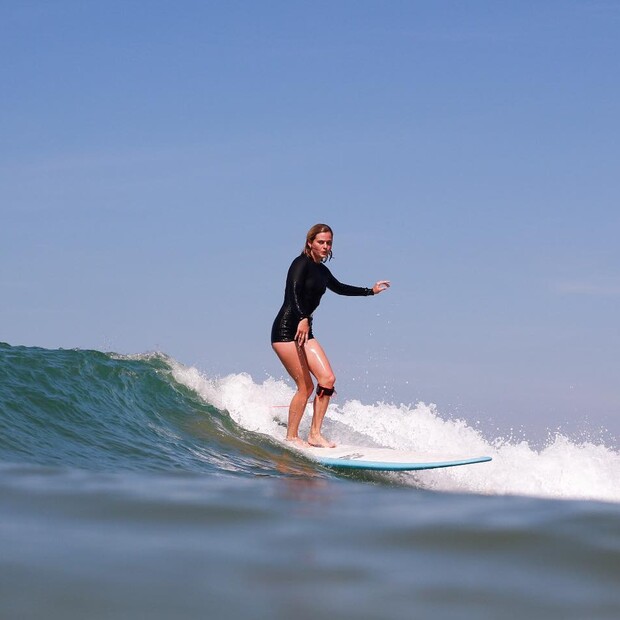
Fancy surfing? Book your surfing vacation now.
Whether you are a beginner looking to ride your first waves or an experienced surfer looking for new challenges - a surfing vacation at A-Frame offers you the ideal opportunity.
Book your surfing vacation now and enjoy:
- Professional surf courses and personal tips from experienced surf instructors
- All-round carefree package including surf course, surf equipment, accommodation & catering
Let yourself be carried away by the waves and experience the freedom of surfing.
Surfboard dimensions
The size of a surfboard is given in feet and inches, with 1 foot being approximately 30.48 centimetres and 1 inch being 2.54 centimetres. For beginners, the surfboard should be at least 30 to 50 cm longer than your own height, which usually corresponds to a length of between 7'2" and 8'2" feet.
Important key figures of a surfboard
A surfboard is described by the following four dimensions:
Length: Measured in feet and inches, influences the speed.
Width: Measured at the widest point, influences the stability.
Thickness: Measured at the thickest point, influences the buoyancy.
Volume: Indicated in liters, it combines the three previous measurements and is particularly important for the buoyancy of the board.
Conversion of measurements
For many, the units feet and inches are unfamiliar at first, but with a little practice you will get a good feel for them. Here is the conversion:
1 foot = 30.48 cm
1 inch = 2.54 cm
These measurements and ratios will help you choose the perfect surfboard to suit your height, ability and surfing conditions.
Finding the perfect surfboard is a compromise
The longer the board, the more speed you can build up when paddling. The wider the board, the more stable it is when surfing a wave. So you have more stability. The thicker a surfboard is, the more neutral buoyancy you have when paddling out. This means the wave will take you sooner. These are all super cool characteristics, and you could assume that a long, thick and wide board has all the advantages and is therefore the perfect surfboard.
But that's not the case: Because the more material there is in the water, the more difficult it is to maneuver a surfboard and make turns with it. When choosing the right surfboard, it is therefore important to find a compromise. Finding a compromise runs through the whole topic of surfboard design.
Volume from the surfboard
Explanation volume surfboard
The volume of a surfboard is given in liters and is measured by the length, width and thickness of a surfboard. The volume is a great comparative figure for a surfboard. This is because you can use the volume to find the balance between your ability and your body weight and thus roughly estimate which board is suitable for you.
The volume of a surfboard is a relatively new specification in surfboard design. Ten years ago, volume did not play a role in surfboard selection. Even today, shapers who shape a surfboard by hand cannot determine the volume of a board. Only since CAD and CNC machines have been used to produce surfboards commercially has this figure been given. Much more important than the volume of a surfboard is the distribution of the volume on the surfboard. Because three boards with the same volume can still be completely different to surf. Example: For example, if a shaper shapes a 38 liter board and places all the material in the nose (i.e. the front part), or vice versa in the tail (back), the behavior of the surfboard will change completely with the same number of liters. So before you buy a surfboard based on volume, pay attention to the distribution throughout the board.
Video Fat Surfer
With the right volume, even overweight people can surf easily. The video is a bit older, but a classic.
Why is the volume of a surfboard important?
Since the "retro revolution" of the early 2000s, an ever-increasing variety of surfboards have been surfed, and today the standard 3 dimensions (length, width and thickness) no longer give us enough information to decide whether a board will work for us or not. You can shape three surfboards with the same dimensions that look and surf very differently. That's why a new metric, volume, has come into play in recent years.
So volume mainly tells you how "buoyant" the surfboard will be and therefore how well the board will float you on the water. This factor is hugely important because the better a surfboard pushes you out of the water, the less resistance your body will generate when paddling and the faster you can move. The faster you can paddle, the more waves you can catch, and the less steep those waves need to be to catch them. However, the volume of the board is only half of the equation, the other part is the weight of the surfer, as a heavier surfer needs more volume to float him.
Calculate surfboard volume
How much volume should my surfboard have? We get asked this question time and time again. There are numerous volume calculators online that work out the supposedly perfect volume for you. We recommend the volume calculator from Surfsimply. All you need is your body weight and your surfing ability (be honest with yourself) and you will get the ideal board volume as a result. In our experience, the surfing level is not adequately estimated by many other calculators.
Typical mistake: The smaller the better?
If you look at the table above, it becomes clear: these surfers have pretty small surfboards. Don't forget that these are the world's best pros. Many surfers, especially beginners, think: If I want to be a really good surfer, I have to surf the smallest possible surfboard. Wrong. Many people who buy their own surfboard make this mistake. The size of the surfboard not only determines how well you surf, but also what and how you want to surf. Larger and more voluminous boards are easier to surf, especially for beginners, as the main aim at the beginning is to get lots of waves and practise your take-off. But advanced surfers who want to surf soft and comfortable waves should also get a larger board. Because with a board that is too small, you won't get these waves and won't enjoy your surfboard as much.

Bought a new surfboard? Book your surfing vacation now.
Now you know all about surfboards. Then now is the perfect time to plan your next surf vacation!
Book your A-Frame surf vacation now and enjoy:
- Professional surf courses and personal tips from experienced surf instructors
- All-round carefree package including surf course, surf equipment, accommodation & meals
Let yourself be carried away by the waves and experience the freedom of surfing.
Materials and construction of surfboards
The choice of materials and the construction of a surfboard have a decisive influence on its performance and durability. Here are the most important aspects you should know:
Core materials
Rigid foam: Most modern surfboards have a core made of rigid foam, either polyurethane (PU) or polystyrene (EPS). PU cores are heavier and offer a traditional flexibility and cushioning that many surfers prefer. EPS cores are lighter and offer more buoyancy, making them particularly suitable for larger and weaker waves. They are also more environmentally friendly as they usually contain fewer harmful substances.
Wood: Wood cores are less commonly used, but offer high strength and a classic feel. They are heavier than foam cores and offer a unique aesthetic and durability. Wood cores are often used in combination with modern materials to combine traditional designs with modern performance characteristics.
Coatings
Polyester: Polyester resin is the traditional material for coating surfboards. It offers good flexibility and is relatively inexpensive. However, polyester boards are heavier and less durable than their epoxy counterparts. They also tend to yellow over time and are more prone to bruising and dents.
Epoxy resin: Epoxy resin is often used in conjunction with EPS cores and offers numerous benefits. It is lighter, stronger and more resistant to dents and pressure marks. Epoxy boards are also more environmentally friendly as they release fewer volatile organic compounds (VOCs). However, these boards have a different flexibility that some traditional surfers may find less comfortable.
Differences in performance and durability
Performance: The choice of material significantly influences the performance of a surfboard. PU cores with polyester resin offer a classic, flexible feel that many surfers prefer, especially in powerful, hollow waves. EPS cores with epoxy resin offer more buoyancy and are lighter, making them ideal for weaker, smaller waves.
Durability: Epoxy boards tend to be more durable and resistant to bumps and dents, making them ideal for surfers who surf regularly and want their board to last a long time. Polyester boards are more susceptible to damage and may require more frequent repairs.
Overall, the choice of material and construction depends on your individual preferences, your surfing style and the conditions in which you mainly surf. By taking these factors into account, you can find the perfect surfboard for your needs.
Shape - nose, tail and rails of surfboards
The shape of a surfboard is crucial for its behavior on the wave. The different elements of the shape - nose, tail and rails - have a significant influence on how the board planes, turns and lies in the water. Each shape has specific characteristics that influence the surfing experience in different ways and are optimized for different surfing conditions and styles.
Surfboard Nose
The nose is located at the very front of the surfboard. It is responsible for paddling and the wave yield. Less volume in the nose means you have less speed when paddling and you won't catch the wave as easily. A lot of volume in the nose is therefore great for catching the wave. For surfing, the volume is no longer so great. The nose is then in the way, so to speak. Because as soon as you surf a wave, the nose has done its part of the work.
When surfing waves, only the rear part of the surfboard is still in the water. If you want to ride a tight turn in the strongest part of the wave (pocket), a wide nose is a hindrance. Because in this case you have to turn a lot of material and that is not so easy. A pointed nose is better in this case.
Which nose for which wave?
The volume of the nose therefore depends on which waves you want to surf and how fit you are as a paddler. If you want to surf steep waves with a lot of power, you can plan for less volume in the front of the surfboard. If you prefer flat and soft waves, a wider nose makes sense. Otherwise, you won't be able to get into the wave in the first place. In such conditions, the turns will also tend to be smoother and more expansive, meaning that a wide nose is not as disruptive.
Surfboard Tail
The tail is located at the back of the surfboard. To be precise, it is the rear third of the board. The volume of the tail also has an influence on surfing.
The tail in powerless waves
Much volume in the back of the surfboard means, for example, that you have more buoyancy when surfing a wave. It is also easier to maintain speed with a lot of volume. So if the wave gives you little thrust and you get into a part of the wave that is rather weak, a lot of volume is better. Because then it's easier to perform your maneuvers with a wide and voluminous tail. "Speed is your friend", as the saying goes - at least most of the time.
The tail in big and powerful waves
In big, powerful waves, a lot of volume in the tail can be a hindrance. This is because you often build up so much speed in powerful waves that the wide tail gets too much lift. You may lose grip.
For waves like this, it would therefore be better to have less volume in the back of the board. The tail then "digs" better into the wave face and you can make controlled turns and hold the line. This is why so-called Guns from big wave surfers have a very compressed tail (pintail). This gives them the best possible control over the surfboard, even at high speeds.
If you've seen videos of these big wave surfers, you're probably wondering: Why doesn't he surf further up and try to surf the wave longer? The problem is the speed: the tail comes out of the water so high that it becomes impossible to control the board. The surfers simply race straight down the wave face into the white water and have no chance of surfing the board along the wave face.
Surfboard tail design
When it comes to tails, people often only talk about the last 20 centimetres and discuss the various tail shapes such as swallow, square, round and squash tails. Probably because it simply stands out visually, but in fact this last part doesn't make that much difference. Rather, you have to judge the entire last third of a board to know how it surfs.
Squash Tail: Provides a good balance between stability and maneuverability, ideal for versatile surfing conditions.
Swallow Tail: Improves maneuverability and offers good grip in smaller waves.
Pin Tail: Provides high stability and control in big, powerful waves
Surfboard rails
Rails are the "round corners" or edges on the left and right of the surfboard. They run along the entire length of the board. Surfboard rails are the decisive factor in how the water moves around your surfboard when you are on the wave. When they are loaded, the surfboard changes direction and you surf a turn. On almost all surfboards, the rails on the nose and tail are kept rather thin to make the board more maneuverable. The rails get thicker towards the middle to guarantee sufficient buoyancy when paddling and surfing a wave. As you can see, every part of the surfboard design is well thought out.
Hard and soft rails
This is information for everyone who wants to know the difference: There are two different types of rails: hard and soft rails. Rails are called hard when the outermost point is pulled downwards and it becomes more angular. Soft rails, on the other hand, are pulled upwards and the rails become rounder.
Simply put, hard rails are more likely to be used on shortboards. This is because they are made for surfing hollow, fast waves. The edgier rails grip better in the wave face and make the surfboard more maneuverable with the right pressure. This enables more radical maneuvers that allow the board to break out in a controlled manner.
Soft rails are used on surfboards that are built for more leisurely waves. These rails provide a lot of lift and forgive the odd mistake when turning the board. The surfboard won't catch a rail so easily, which means you won't get stuck or fall so easily. Round, thick rails guarantee more fun, especially in weak waves.
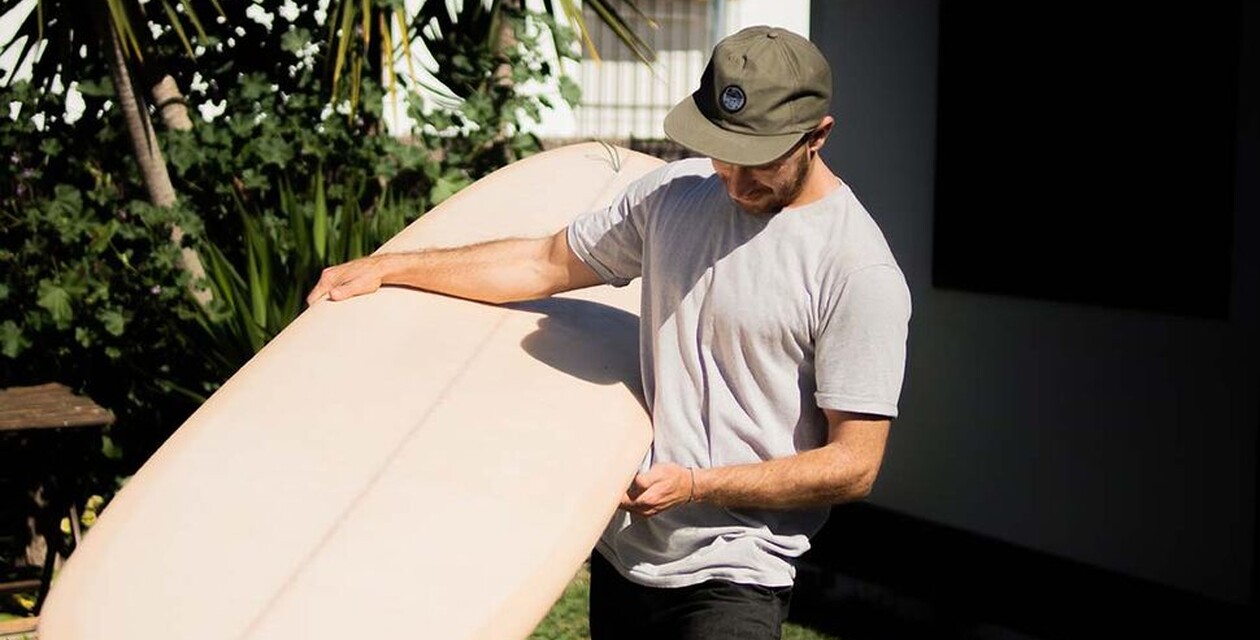
Concave vs. convex
Bottom condition of a surfboard
Another important aspect of surfboard design is the shape of the surfboard's bottom. You can either work with so-called channels (concave), which channel the water to the fins and thus make it faster.
Or you can build in a small bulge (convex). This gives you more control over your surfboard when you want to move the board from one rail to the other.
You can also leave the bottom of the surfboard flat. A flat bottom is not a problem in small waves. However, above a certain speed it becomes difficult to control. Most modern surfboards combine a mix of the different options. The shaper can get creative here. Single to double concave, belly to vee, single to flat etc.. The variable of the bottom condition is an often overlooked but very important component. This is because it also determines how the board will feel and surf.
Surfboard fins
The fins are also an important factor in surfboard design. Because the fins keep us on track when surfing. Try it out for yourself and surf your board with different fins or a different fin arrangement. You will notice a big difference. The number, arrangement and size of the fins make all the difference:
Single Fin
The oldest Finn setup. However, it is also the slowest of all. This is because there is a lot of water turbulence around the fin during the ride. On the other hand, you have a good grip when trimming in the wave. The single fin setup is typically used on longboards, minimalibus and retroboards.
Twin Fin
Twin fins are the second oldest fin setup. The water is channeled between the two fins. This makes the board very fast and responsive. Due to the speed, you sometimes have problems in larger waves. This makes the surfboard harder to control. In smaller conditions, you can have a lot of fun with it. Because then you will definitely enjoy the extra speed. Quick changes of direction are also easy with this fin setup.
Quad fins
The Quad consists of four outer fins without center fins. As with the Twin Fin, there is no center fin to interfere with the water flow, making the surfboard very fast. It offers a little more stability thanks to the two extra fins. This means you can surf bigger waves with it. As previously described, speed is not always helpful when controlling a board. It can happen that you "miss" parts of the wave where you could actually make a powerful maneuver. The quad has a very similar range of use to the twin fin setup, but it is easier to turn. This is because the fins are positioned further out, making the transition from one rail to the other easier.
Thruster fins
The Australian Simon Anderson is considered the inventor of the thruster setup in the 80s. This fin setup uses three fins of the same size instead of just two. Thanks to the so-called center fin, this fin setup offers good grip in the water. The two outer fins help the surfboard to turn easily. This was a revolution in the 80s. Thanks to this achievement, even more vertical maneuvers were suddenly possible on the wave. It also allowed surfers to be more creative in finding lines on the wave. This setup has prevailed and is used on most modern surfboards today. It is even the standard fin setup for contest surfers.
Care and maintenance of surfboards
To ensure that your surfboard lasts a long time and always remains in optimum condition, regular care and maintenance is essential. Here are some tips on proper storage, repairing dents and scratches and cleaning and caring for the fins.
Correct storage
Dry and cool environment: Store your surfboard in a dry and cool place to prevent damage from UV rays and moisture. Direct sunlight can weaken the material of the board and lead to yellowing.
Protection from pressure points: Use a padded board bag to protect the board from pressure points and scratches. Make sure that it does not lie on sharp or hard objects.
Store upright: If possible, stand the board upright on the tail or hang it horizontally to avoid deformation.
Repair of dents and scratches
Small scratches: These can often be smoothed out with sandpaper and sealed with special surfboard repair resin. Make sure the surface is clean and dry before applying the resin.
Dents and major damage: For major damage, it may be necessary to use fiber reinforcement and epoxy resin. Apply the resin to the damaged area, place a fiberglass mat over it and coat it again with resin. Allow everything to cure completely and sand the surface smooth.
Professional repair: If the damage is serious or if you are unsure, it is advisable to take the board to a professional repair service.
Cleaning and care of the fins
Regular cleaning: Remove sand, salt and dirt after each session. Rinse the fins with fresh water to prevent corrosion and deposits.
Check the fin boxes: Regularly check the fin boxes for cracks or loose screws. Tighten loose screws and repair small cracks with epoxy resin.
Removing and storing: If you don't use your board for a long time, remove the fins and store them separately to prevent damage and deformation.
Additional equipment for surfing
In addition to the right surfboard, complementary equipment is crucial to ensure safety, comfort and performance on the water. Here are the most important pieces of equipment:
Leash (safety line)
Explanation: The leash is a safety line that connects the surfboard to the surfer's foot. It prevents the board from drifting away after a fall and protects other surfers from an uncontrollably drifting board.
Advantages:
Safety: Keeps the board close to the surfer and prevents injury to others.
Comfort: Makes it easier to get back on the board quickly after a fall.
Tips:
Choose a leash that is about as long as your surfboard.
Check the leash regularly for wear and replace it if necessary.
Wax for the surfboard
Explanation: Wax is applied to the top of the surfboard to improve grip and prevent slipping.
Benefits:
Grip: Improves the grip of the feet on the board, which is particularly important when paddling and standing up.
Performance: Helps to maintain control of the board, especially during maneuvers.
Tips:
Apply the wax to the surface of the board in an even pattern.
Use the right wax depending on the water temperature (cold, cool, warm, tropical).
Wetsuit and other protective equipment
Wetsuit: A wetsuit keeps the surfer warm and protects against the cold, UV rays and injuries caused by sharp reefs or jellyfish. They are available in different thicknesses depending on the water temperature and surfing conditions.
Advantages:
Warmth protection: Enables longer surfing sessions in cold water.
Protection: Provides additional protection against injuries and sunburn.
Other protective equipment:
Booties: Protect feet from cold water and sharp surfaces.
Gloves: Provide additional thermal protection for hands in very cold water.
Hood: Protects the head and ears in extremely cold water and prevents heat loss.
Tip: Also read our blog article "Neoprene wetsuit - Everything, what you need to know" and "Washing your wetsuit - How to care for your wetsuit properly"
This complementary equipment ensures that you can surf safely and comfortably, regardless of the conditions. It helps you maximize your surfing performance and get the most out of every session. :)
Tips for buying a surfboard
Choosing the right surfboard is crucial for your success and fun on the water. Here are some important aspects you should consider when deciding between a new and used surfboard, as well as other factors to look out for when buying one.
New vs. used surfboard
New surfboard
Advantages:
Condition: No wear or damage. You can be sure that the board is in perfect condition.
Customization: Possibility to customize the board according to your specific requirements and preferences.
Guarantee: Often provided with manufacturer's warranty.
Disadvantages:
Price: Higher purchase price compared to used boards.
Wear and tear: The first scratches and dents are particularly painful on a new, expensive board.
Used surfboard
Advantages:
Price: Significantly cheaper than new boards, which can be particularly advantageous for beginners.
Availability: Many used boards are available immediately, with no waiting time.
Disadvantages:
Condition: Possible wear, dents or repairs that can affect performance.
Lifespan: Shorter than a new board, depending on the condition and maintenance by the previous owner.
What to look out for when buying a surfboard
Choosing the right surfboard size Many beginner surfers tend to choose a surfboard that is too small. Paddling onto a wave becomes a struggle, the take-off is wobbly and the glide is short-lived fun. Larger surfboards are more stable and glide better, which makes learning to surf easier. The more time you spend standing on the surfboard, the more experience you can gain. However, a board that is too big can make it difficult to perform radical maneuvers.
Body size, weight & surf level The length, weight and volume of a surfboard depend on your height, weight and ability:
Body size: The bigger you are, the longer your surfboard should be.
Weight: The heavier you are, the more volume your board should have.
Skill: The better you are, the shorter your board should be.
Series boards or from a shaper If you have your board built directly by a shaper, it may be more expensive but has the advantage of being tailored to your specific needs. Buying a surfboard used or new off the shelf is often cheaper. However, you should be familiar with the typical features of surfboard design and be able to correctly assess your surfing level.
Which spots and conditions do you want to surf? The choice of surfboard also depends on your preferred surf spots and the prevailing conditions there. Do you mainly want to ride knee-high waves or are you aiming for bigger and more powerful waves soon? Your surfboard should suit the wave conditions you want to surf regularly.
Try out different boards before you buy a surfboard Especially as a surf beginner, you should take every opportunity to try out different surfboards. Test different sizes, volumes and shapes, borrow boards from a surf rental shop or swap boards with friends. That way, you'll find out which surfboard is right for you.
Read our detailed blog article on the topic:
Manufacture and sale of surfboards
Production volume and sales
Several million surfboards are sold worldwide every year. It is estimated that around 500,000 to 700,000 surfboards are sold each year in the USA alone, although the global market is much larger. Demand for surfboards is growing continuously as surfing becomes increasingly popular and new markets in Europe, Asia and South America are also being tapped into.
Production sites
Surfboards are manufactured worldwide, with major production sites in the USA, Australia, Indonesia and Europe. California and Hawaii are well-known centers of surfboard production in the USA, while in Europe countries such as Portugal and France are major manufacturers. Indonesia has also become an important production location due to low production costs and favorable climatic conditions.
Difference between a shaper and industrial production
Shaper: A shaper is a craftsman who customizes surfboards. These boards are often designed according to the specific needs and wishes of the surfer. The shaper works closely with the surfer to develop the perfect dimensions, materials and designs. Each board made by a shaper is unique and reflects the shaper's expertise and creativity. These handmade boards are often more expensive and require a longer production time, but offer customized performance and a personal touch.
Industrial manufacturing: In contrast to this is the industrial manufacturing of surfboards, where mass production techniques are used. These boards are manufactured in large quantities, often with the help of machines and standardized processes. This enables more cost-effective production and faster availability of the boards. Industrially manufactured surfboards are generally cheaper and can offer consistent quality through the use of modern technologies. However, they lack the customization and handcrafted charm that a board from a shaper offers.
Advantages and disadvantages:
Shaper: Tailor-made, high quality, personal customization, higher price, longer production time.
Industrial manufacturing: Lower cost, faster production, consistent quality, less customization.
The choice between a handmade board from the shaper and an industrially manufactured board depends on the surfer's individual needs and preferences. Both options have their own merits and may be the better choice depending on the situation.
These aspects of surfboard production and marketing show how diverse and dynamic the surf industry is, and illustrate the importance of both traditional craftsmanship and modern industrial processes in today's surfing world.
Video of the surfboard shaper
Here you can see how a shaper makes a surfboard.
Conclusion surfboard
Surfing is a fascinating sport that requires not only physical fitness, but also a deep understanding of the sea and the waves. Choosing the right surfboard is crucial to the success and enjoyment of surfing. In this article, we have covered the different types of surfboards and their specific features, the important dimensions and their influence on performance, as well as the complementary equipment for a safe and comfortable surfing experience.
Summary of the most important points
Types of surfboards: From the stable longboard to the manoeuvrable shortboard to specialized boards such as gun boards and tow-in boards - each board has its own specific areas of use and advantages.
Important features: Size and volume influence the stability and manoeuvrability of the board. The shape and the arrangement of the fins are crucial for control and speed.
Supplementary equipment: A good leash, the right wax and a suitable wetsuit are essential for safety and comfort.
Motivation and tips for getting into surfing
If you want to get into surfing, start with a longboard or funboard that offers you stability and easy handling. Take a surfing course to learn the basics from a professional surf instructor and practice regularly to improve your skills. Make sure to take good care of your surfboard and equipment so that they will last you a long time.
Surfing requires patience and perseverance, but the reward is an incomparable feeling of freedom and connection with the sea. With the right preparation and equipment, you'll be ready to conquer the waves and enjoy surfing to the full.
So, grab your board, get in the water and enjoy the journey - the waves are waiting for you!
